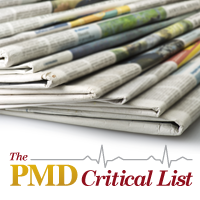- Revenue Cycle Management
- COVID-19
- Reimbursement
- Diabetes Awareness Month
- Risk Management
- Patient Retention
- Staffing
- Medical Economics® 100th Anniversary
- Coding and documentation
- Business of Endocrinology
- Telehealth
- Physicians Financial News
- Cybersecurity
- Cardiovascular Clinical Consult
- Locum Tenens, brought to you by LocumLife®
- Weight Management
- Business of Women's Health
- Practice Efficiency
- Finance and Wealth
- EHRs
- Remote Patient Monitoring
- Sponsored Webinars
- Medical Technology
- Billing and collections
- Acute Pain Management
- Exclusive Content
- Value-based Care
- Business of Pediatrics
- Concierge Medicine 2.0 by Castle Connolly Private Health Partners
- Practice Growth
- Concierge Medicine
- Business of Cardiology
- Implementing the Topcon Ocular Telehealth Platform
- Malpractice
- Influenza
- Sexual Health
- Chronic Conditions
- Technology
- Legal and Policy
- Money
- Opinion
- Vaccines
- Practice Management
- Patient Relations
- Careers
The PMD Critical List: The Huge Cost of Reporting Data to Insurers
Physicians spend hundreds of hours each year reporting data to insurance companies, for a total tab of more than $15 billion worth of time. That story tops this week’s PMD Critical List. Also making the list: Infection rates remain a stubborn problem, and one state outlaws paper prescriptions.

Physicians spend hundreds of hours each year reporting data to insurance companies, for a total tab of more than $15 billion worth of time. That story tops this week’s PMD Critical List. Also making the list: Infection rates remain a stubborn problem, and one state outlaws paper prescriptions.
• Billions Spent to Provide Insurance Data (Weill Cornell Medical College)
A recent Health Affairs report shows that US medical practices in four specialties—orthopedics, cardiology, family care, and internal medicine—spend 15 hours a week, or an astounding $15 billion annually, reporting data to private insurance companies, Medicare, and Medicaid.
• US Hospitals: “Still Too Many Infections” (The Leapfrog Group)
In the midst of Patient Safety Awareness Week, a new survey finds that while “hospitals are making strides in avoiding central line-associated blood stream infections and catheter-associated urinary tract infections, patients are still experiencing these serious, and sometimes fatal, infections too frequently.”
• The End of Prescriptions as We Know Them (The New York Times)
The way prescriptions are written in New York State is changing. “Gone will be doctors’ prescription pads and famously bad handwriting. In their place: pointing and clicking, as prescriptions are created electronically and zapped straight to pharmacies in all but the most exceptional circumstances.”
• Why Business Loves Doctors Right Now (Fortune)
Physicians’ offices are increasingly being snapped up by hospitals and investors alike—acquisitions rose nearly 50% in 2015. Concierge medicine is the attraction. There are about 6,000 US concierge-style medical offices now, up 25% just in recent years and experts believe that the number could quickly triple.
• Match Day 2016: Increases All Around (MedPageToday)
This past week “medical school students and graduates participated in the largest National Resident Matching Program (NRMP) in history with 42,370 registered applicants. Here’s a report about one of the more momentous days in the life of an American physician. “Thousands of futures are in the hands of an algorithm.”
• Dollars for Docs: Does Big Pharma Own Physicians? (ProPublica)
The more money doctors receive from drug and medical device companies, the more brand-name drugs they tend to prescribe, a new analysis shows. “You can debate if these payments are good or bad, or neither, but what isn’t debatable is that they permeate the profession,” says the director of the Center for Pharmaceutical Policy and Prescribing.
• Doctors More Likely to Misdiagnose “Difficult Patients” (Independent)
A British Medical Journal study “has found that the likelihood of being misdiagnosed dramatically increases when a doctor is presented with a “difficult” patient who obstructs the clinician’s efforts by being aggressive or questioning their competence.”
• ER Doctors Avoid These Everyday Items (CNN)
“Emergency room physicians see all kinds of grisly stuff, which made us wonder: What products do they consider so hazardous they ban them from their homes and yards?” These every day items include: Button batteries, power washers, extension ladders, trampolines, and Ramen noodle soups.
• CDC Issues Tough New Guidelines on Painkillers (Health.com)
Hoping to stem an epidemic of drug abuse tied to narcotic painkillers, federal officials issued new prescribing rules to the nation’s doctors “stressing they should try to avoid these addictive “opioid” painkillers whenever possible for patients with most forms of chronic pain.”
• More Doctors Prescribing Exercise Instead of Meds (Seattle Times)
Doctors treating chronic health problems increasingly are prescribing exercise for their patients. “Exercise is not a new medicine. It’s really an old medicine,” one doctor explains. “But we’re now coming to the point of understanding how important it is.”
• Few Physicians Rewarded for High-Quality Care (New Pittsburgh Courier)
Nearly 40% of 13,800 physician groups nationwide will have their payments reduced from Medicare this year under the Value Modifier program for either poor performance or a lack of participation in a program evaluating quality of care.
